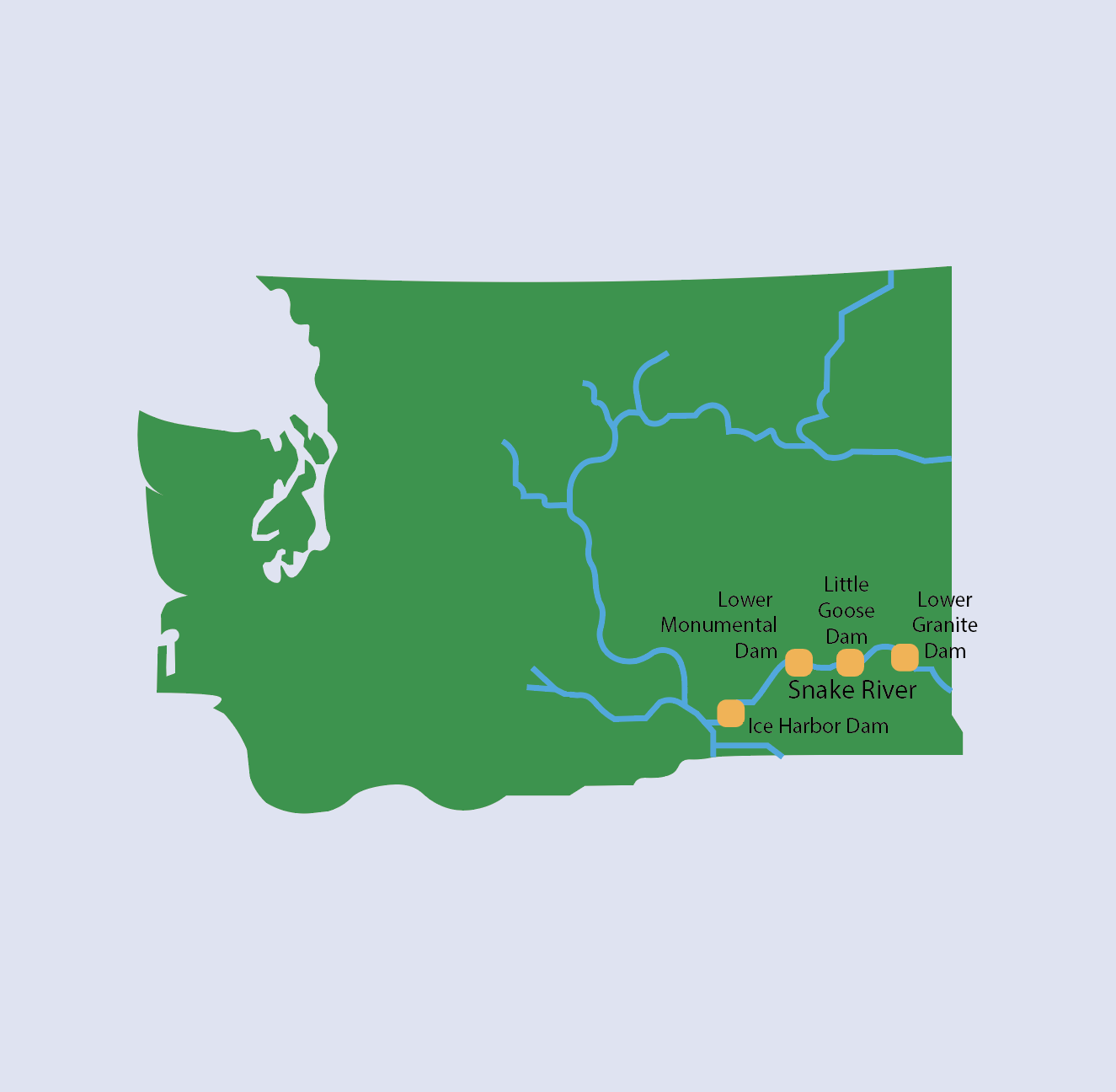Before the 1900s, the Columbia River Basin produced between 10 million and 16 million salmon annually, but this number has dwindled to an average of 660,000 in recent years. One factor behind this decline lies within the hydroelectric dams on the Columbia River Basin. The basin supports all five species of salmon that live in North American waters, including Chinook, Coho, Sockeye, Steelhead and Chum.
On July 11, the National Oceanic and Atmospheric Administration (NOAA) released a report that recommended four out of the 18 dams be removed for the sake of local wildlife. Last month, Gov. Jay Inslee (he/him) and Sen. Patty Murrary (she/her) concluded that the Lower Snake River dams will not be breached unless they are presented with an feasible option of doing so that will ensure the benefits the dams provide don’t outweigh their cause for removal.
The Snake River dams are a flood risk to people in Clarkson and Lewiston, two cities close to the dams. The dams don’t have the ability to store any water, meaning once the reservoirs are filled, the excess water flows behind the Lower Granite dams. This causes the Lower Granite river water levels to gradually rise, forming severe flood risks. The only attainable resolution is to remove the lower Snake River dams, not only for neighbors of the dams, but also for all of Washington.
Some proponents of the dams argue that because they serve as a clean power source, their removal would cause an increase in carbon emissions. However, the small amount of energy produced by the four dams up for removal doesn’t need to be replaced by fossil-fueled energy sources:solar power and wind turbines are viable alternatives.
The four dams’ annual energy output is roughly what the city of Seattle would need: 1,000 megawatts. Because the amount of power they generate relies on the water available to spin turbines, the amount is reduced for almost half of the year (especially in winter and late summer).
The dams also allow freight ships to carry goods across the state, something only trains could do prior to the dams’ construction in 1975. However, there are more environmentally-friendly methods of transportation available to replace freight ships in the event of the dams’ removal. Moreover, the need to remove the dams for the sake of the salmon population, which lies on the brink of extinction, outweighs the need to transport commercial goods.
In the NOAA’s July 11 report, the Snake River’s spring and summer Chinook salmon were labeled as the highest priority to conserve. The spring and summer Chinooks previously had 68 established historical populations but now have only 28. West Coast Salmon and Steelhead are listed as threatened under the Endangered Species Act. The Chinook salmon movement is slowed or altogether stopped when traveling through these dams via a fish ladder — structures built so fish can bypass barriers and move upstream. This increases stress on the juvenile fish and results in deaths when reaching the Pacific Ocean.
Many other species of fish are harmed by hydroelectric dams. NOAA found that the mainstream adult fish ladders limit the passage of half the adult Pacific Lamprey. Fewer than 1% make it to the upper Columbia and Snake River Basin where they can access more food and space to thrive.. Currently, there is no path for adult white sturgeons through the lower Snake River, limiting their habitat and spawning areas.
Although no single action is enough to fully rebuild salmon and steelhead populations, the lower Snake River dams must be removed in order to reverse the generations of declining populations.
Taxpayers should be aware that large amounts of their money are regularly used to restore salmon habitats in the Snake River. Over the last two decades, eight billion dollars have been ineffectively spent by federal agencies in failed attempts to recover salmon populations. All this money went to unscientific endeavors, such as loading salmon into trucks and driving them around the dams so they wouldn’t have to exhaust themselves traveling through them. Yes, feds thought this was a good solution. They continuously ignored the cost-effective idea of removing the lower Snake River dams, all while emptying the pockets of oblivious taxpayers.
Since 2002, the General Accountability Office (the investigative arm of Congress) has stated there is little solid evidence that the last twenty years of federal salmon recovery actions have been effective. This shows there is no positive correlation between expensive restoration projects and benefiting the salmon population. If the dams are not removed, everyone’s salaries will be repeatedly used to fund unsuccessful attempts to recover the rapidly-declining salmon population.
Since the 1990s, people in the Pacific Northwest have been protesting the removal of the lower four dams, and yet, it’s necessary. We have a responsibility to elect officials who aren’t afraid to protect local wildlife and remove these destructive dams.



















J Martell • Nov 30, 2022 at 3:37 PM
The First Nation folks have treaty promises for the fish rights that have been ignored.
Leslie Moore • Nov 20, 2022 at 9:00 PM
I think if you’re going to remove the lower snake River dams, you need to take all of the Columbia River dams out to have free flowing water and a return of the salmon, but that won’t happen. The governorship of Washington won’t allow that or Oregon because their Democrats and they could give a crap about the people that live in the upper part of the rivers and what the result of removing those rivers is going to be a huge amount of silk and stuff that’s going to probably do away with a lot of bass, walleye and of course the protected, sturgeon. I feel that this hasn’t been thought through very well and someone is making a lot of money. Thank you
Mr. Moore
Dennis • Nov 20, 2022 at 3:56 PM
I love this approach even if expensive. I have been a salmon fisherman my whole life. We need to change or lose this resource forever.
Scott Heffernan • Nov 19, 2022 at 2:13 PM
It’s time.
Do it now before we wish we had.
Serena • Nov 27, 2022 at 6:10 PM
We already wish they were gone!